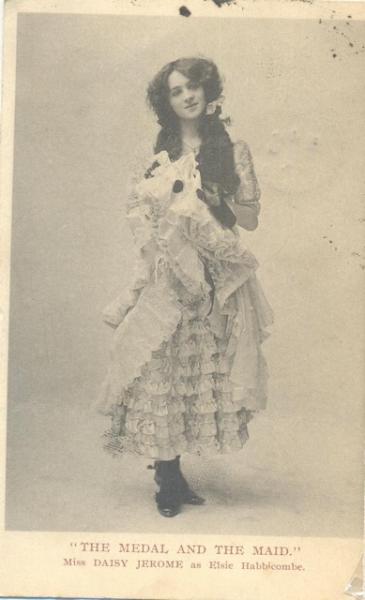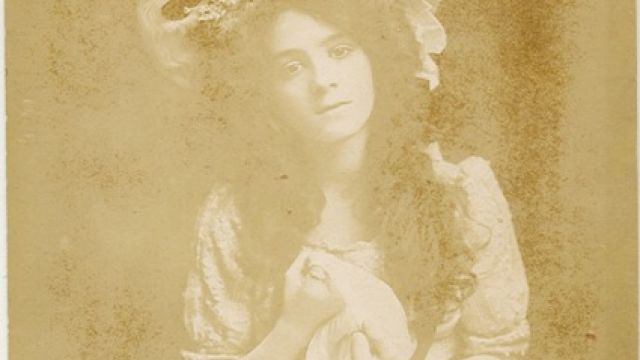The Redhead who Electrified the Australian Stage
Australia has a controversial redhead as its leader. Just on a century ago it was a redhead on stage, with a famous wicked wink, who set tongues wagging. Leann Richards reports on the scandalous life and times of Daisy Jerome.
In 1913 fashions and attitudes were changing quickly. Early that year suffragettes marched in the US and later the shocking Argentine tango was introduced to western society. It reached Australia in late 1913 and almost simultaneously, a young music hall artist called Daisy Jerome arrived in the country.
When Daisy landed in Adelaide that year she was dripping with jewels and carried a scent of the scandalous. The American born, but English raised, comedienne was a small woman of slight build with a head topped with a mop of long carroty red hair. She had a sparkling, wicked sense of humour and a vibrant manner.
According to census records she was born Daisy Witkowski in 1886 in New York. According to Daisy, she was brought up in a multilingual household, which had been visited by Abraham Lincoln, McKinley and Roosevelt. Her father suffered a financial disaster and when she was six the family moved to England.
There she played the Palace and toured the provinces with a comedic singing and quick-change turn. She acted in pantomime in Manchester and toured the continent. Her performances were slightly cheeky, but very popular. The contrast between the slightly built, dainty Daisy and the content of her songs was a major part of her appeal.
Daisy was a feisty product of a system, which required toughness, cunning, and an independent spirit. She had deserted her first husband, Mr Fowler, a year after their marriage to live with a Mr Allen. During the divorce proceedings, Mr Fowler suggested that the presence of his mother-in-law had destroyed the marriage.
In 1910 Daisy sued a journalist for libel. The reporter accused Daisy of performing encores when the audience had made no request for them. Daisy maintained that this damaged her professional reputation. The proceedings were farcical. Daisy’s song, ‘ A little pat of butter’, a ditty of dubious meaning which included a disparaging verse about Neville Chamberlain, was ridiculed by the defence and Daisy was reduced to tears in the witness box. However, she won the case and was awarded the grand sum of a farthing for her trouble.
It was this unconventional vibrant personality that arrived in Australia in the scandalous year of 1913. Her bright red hair and aura of naughtiness made her a focus of press attention during her three-year tour. She was under contract to J C Williamson and earning the large sum of 150 pounds a week.
Her first appearance was in Sydney as one of the stars of Australia’s first revue, Come Over Here. The critics panned the show, however Sydney’s reviewers enjoyed Daisy’s part in the show. The contrast between her delicate ladylike frame and the raucous vulgarity of her comic songs presented in a hoarse sensual voice shocked audiences, and journalists firmly declared that Daisy was ‘an acquired taste.’ Daisy agreed with this assessment. She later said that the audiences were cold. It may have been her bright red hair, the quick changes of costume or the famous wicked wink that shocked them. However, she eventually charmed the sceptics and by the time the show arrived in Melbourne, she was warmly welcomed and christened with the nickname ‘The electric spark.’
Her red hair was a source of gossip and speculation. Daisy assured audiences and press that it was her natural colour, but few believed her. It was such a source of controversy that a comedian Jack Cannot used it as a gag.
In Melbourne, he informed Daisy that a gentleman had taken offence to her hair. Daisy was indignant, but the Australian comedian declared that the offended gentleman would visit her that night.

The comedian then rang the local fire brigade and spoke to the superintendent. He told him that there was a grave risk of fire during Miss Daisy Jerome’s turn on stage that night. Superintendent Lee was worried and agreed to visit the theatre to assess the fire risk. Upon meeting Daisy, Mr Lee immediately sensed the problem and the joke. ‘I agree, there is a danger of fire,’ he said ‘The scenery should be fireproofed at once.’
Red hair was a source of superstition and had long been associated with bad tempers and scandalous sexuality. When combined with a theatrical profession and a music hall background it was even more outrageous. Daisy’s stage persona capitalised on the evil reputation of red heads, but she also sought to maintain some respectability by insisting her carrot top was natural, not dyed.
After her contract with Williamson lapsed, Daisy was offered another large contract for vaudeville by another producer. This gave Daisy the opportunity to showcase the naughty songs that were her specialty.
In Brisbane in October 1914 she sang, ‘When you go to the seaside’ and two of her signature tunes, ‘Row Row Row’ and the pro-female ‘The Press, the Pulpit and the Petticoat’. The last compared the powers of the media and the church to the power of women, with women declared the most important and influential.
Daisy was a modern lady and held opinions which were regarded as unconventional. In Adelaide in 1914 she told an interviewer, ‘I refuse to regulate my acts to accepted rules of conduct.’
Independent minded, Daisy was happy to pay for herself rather than rely on a man. She thought the fact that she earned more than most men meant that she should pay her own ‘whack.’ Her statements to the press were unusual for the period, but Daisy’s popularity with audiences did not fail and she had a successful tour of the major cities of Australia and New Zealand.
Daisy also toured regional centres of Australia and visited mining towns in Queensland and New South Wales. In Brisbane she performed for visitors and for prisoners, and everywhere she participated in benefits for the war effort.
Daisy left Australia in 1916 but returned in 1922 for another successful and dramatic tour. There was a scandalous court case involving missing jewels and a new husband with an exotic French name. She stayed unconventional and cheeky, but her style faded from popularity with the advent of film and shortly afterwards she disappeared into the shadows of history.
Read more Stage Whispers history stories www.stagewhispers.com.au/history
See more articles by Leann Richards at www.hat-archive.com
Visit Leann's blog www.hat-archive.blogspot.com/
Originally published in the May / June 2012 print edition of Stage Whispers.

